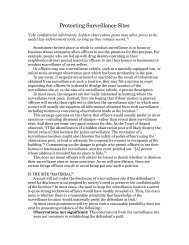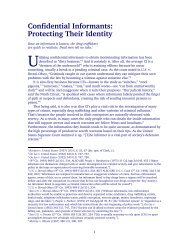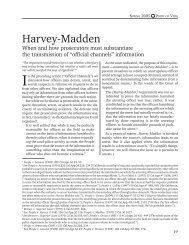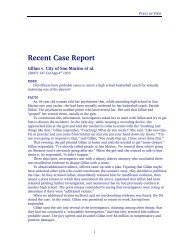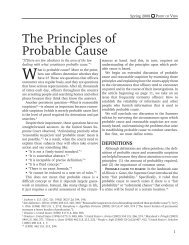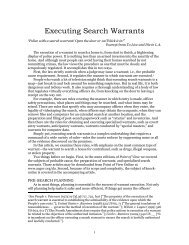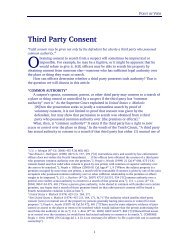PC TO ARREST.pmd - Alameda County District Attorney's Office
PC TO ARREST.pmd - Alameda County District Attorney's Office
PC TO ARREST.pmd - Alameda County District Attorney's Office
You also want an ePaper? Increase the reach of your titles
YUMPU automatically turns print PDFs into web optimized ePapers that Google loves.
ALAMEDA COUNTY DISTRICT AT<strong>TO</strong>RNEY’S OFFICE<br />
and his companion were standing in almost total<br />
darkness on a sidewalk next to a car parked in a<br />
residential area. These facts led <strong>Office</strong>r Stackhouse<br />
to suspect that an auto burglary might be progress.<br />
That suspicion was reasonable.” 162<br />
Lies and Evasions<br />
When a suspect lies, evades a question, gives<br />
conflicting statements, or tells unbelievable stories<br />
it is only natural to assume that the truth would land<br />
him in jail. As the Court of Appeal noted:<br />
Consciousness of guilt is shown by fabrications<br />
which, like devious alibis, are apparently motivated<br />
by fear of detection, or which, like devious<br />
explanations of the possession of stolen<br />
goods, suggest that there is no honest explanation<br />
for the incriminating circumstances. 163<br />
OUTRIGHT LIES: All lies are significant, but especially<br />
if they pertained to a material issue of guilt.<br />
Said the Court of Appeal, “Deliberately false statements<br />
to the police about matters that are within a<br />
suspect’s knowledge and materially relate to his or<br />
her guilt or innocence have long been considered<br />
cogent evidence of consciousness of guilt.” 164<br />
Although somewhat less incriminating, lies pertaining<br />
to peripheral or secondary issues are also<br />
inherently suspicious. The following are examples:<br />
� suspect lied about his name, address, or DOB 165<br />
� suspect lied about where he was coming from 166<br />
� suspect lied about not having a car trunk key 167<br />
� suspect lied that he owned a certain car 168<br />
� suspect lied that the murder victim was his wife 169<br />
� suspect lied that he didn’t know his accomplice 170<br />
14<br />
SUSPECT GIVES CONFLICTING STATEMENTS: A suspect<br />
who is making up a story while being questioned<br />
will frequently give conflicting statements<br />
because he forgot what he said earlier. Again, this is<br />
especially incriminating if the conflict pertained to<br />
a material issue. 171 For example, in People v. Memro<br />
the California Supreme Court pointed out that “patently<br />
inconsistent statements on such a vital matter<br />
as the whereabouts of [the murder victim] near the<br />
time he vanished had no discernible innocent meaning<br />
and strongly indicated consciousness of guilt.” 172<br />
Similarly, in People v. Gravatt the court ruled that<br />
officers had probable cause to arrest the defendant<br />
for possession of a stolen TV in the trunk of his car<br />
mainly because he initially claimed that the set belonged<br />
to his brother-in-law, but then said he won it<br />
in a crap game. 173<br />
TWO SUSPECTS, TWO S<strong>TO</strong>RIES: When two or more<br />
suspects are questioned separately, they will often<br />
give conflicting statements because they don’t know<br />
what the other said. For example, in another stolen-<br />
TV-in-the-trunk case, the defendant said the TV<br />
belonged to a guy who wanted him to sell it, but his<br />
accomplice said it belonged to the defendant. 174 The<br />
court said the whole thing sounded fishy.<br />
Inconsistencies often crop up when officers stop<br />
a car and question the occupants separately about<br />
where they were going and why. 175 Although these<br />
inconsistencies will not necessarily establish grounds<br />
to arrest or prolong the detention, they naturally<br />
raise a suspicion that the trip involved something<br />
shady. For example, in U.S. v. Guerrero176 one of two<br />
suspected drug couriers said they were headed to<br />
Kansas City “to work construction,” while the other<br />
162 th (1994) 9 Cal.4 224, 241.<br />
163 th People v. Carrillo (1995) 37 Cal.App.4 1662, 1670.<br />
164 th People v. Williams (2000) 79 Cal.App.4 1157, 1167.<br />
165 People v. Superior Court (Price) (1982) 137 Cal.App.3d 90, 97; People v. Huerta (1990) 218 Cal.App.3d 744, 750.<br />
166 People v. Suennen (1980) 114 Cal.App.3d 192, 199.<br />
167 See People v. Hunter (2005) 133 Cal.App.4th 371, 379, fn5.<br />
168 th People v. Carrillo (1995) 37 Cal.App.4 1662, 1668-71.<br />
169 th U.S. v. Wong (9 Cir. 2003) 334 F.3d 831.<br />
170 th th See U.S. v. Holzman (9 Cir. 1989) 871 F.2d 1496, 1503; U.S. v. Ayon-Meza (9 Cir. 1999) 177 F.3d 1130, 1133.<br />
171 th th U.S. v. $109,179 (9 Cir. 2000) 228 F.3d 1080, 1085; U.S. v. Boyce (11 Cir. 2003) 351 F.3d 1102, 1109.<br />
172 th (1995) 11 Cal.4 786, 843.<br />
173 (1971) 22 Cal.App.3d 133, 137.<br />
174 People v. Garcia (1981) 121 Cal.App.3d 239, 246.<br />
175 th th See U.S. v. Guerrero (10 Cir. 2007) 472 F.3d 784, 788; U.S. v. Williams (10 Cir. 2005) 403 F.3d 1203.<br />
176 th th (10 Cir. 2007) 472 F.3d 784, 788. ALSO SEE U.S. v. Gill (8 Cir. 2008) 513 F.3d 836, 844-5.



